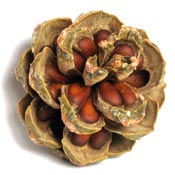The History of Pinon Nut Harvests Reported in Newspapers
Prepared by Penny Frazier
It is said that the Navajo Indians of New Mexico are unusually prosperous this year on account of the arge crop of pinon nuts. It is the first crop have had ...
1925
- In 1925, a good seed year, 1200000 pounds of shelled pinon nuts were shipped out of New Mexico alone, according to available Forest Service records. The gathering of pinon nuts is an important seasonal job for certain residents, especially the native Mexican
1927
In checking figures on Navajo income in 1927, the author was surprised to find that they received a larger total sum from the sale of pinon nuts than from the sale of rugs and blankets
Jan 16, 1932
... families to recoup losses caused by drought and poor market by gathering pinon nuts, of a fair crop occurs only once in three, five or seven years
Feb 6, 1932
For the first time in seven years there had been a good crop of mountain pinon nuts. The Indians had left their flocks in charge of little boys and gone ...
Nov 4, 1934
Here, this fail the game is in excellent condition, due to the unusually plentiful crop of pinon nuts upon which the deer are feeding1945,The pinon nuts yielded the Navajo an income of $390,000 in 1945, which is more than the combined value of both rugs and silver which they produced.
light in others, while there have been some years when the crop was a total failure. The amount received by the Navajo from wages increased enormously in the years following the outbreak of the war. Doubtless the future years will see considerable decline of income from this source.
BIG PINON CROP ON THE FORESTS .
Dec 15, 1937
- The 1937 production that of an ordinary crop, according to the reports, although the yield of pinon nuts 'vanes greatly, ranging from lesh than a million ...
Superintendent J. M. Stewart to E. E. Dale, October n, 1946.
New York Times - Mar 12, 1949
Fall sheep prices were good, and there was an exceptional crop of pinon nuts, another important source of income.
Pine nut development in North America is modest in comparison with that in Europe. The Italian pine tree, with superior timber, is larger and grows faster than the stunted pinon of the southwestern United States. Italian stone pine plantations are well established in Mediterranean Europe, via order of the pope in the mid 1600's.The American pinon has remained mostly neglected and uncultivated.
About European Pine nuts




